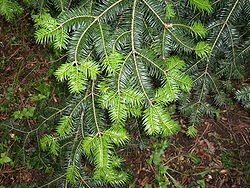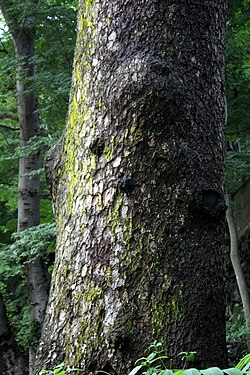Manchurian fir
| Manchurian fir | ||||||||||||
|---|---|---|---|---|---|---|---|---|---|---|---|---|

Seed cone-bearing crown of a Manchurian fir in the Botanical Garden Munich-Nymphenburg |
||||||||||||
| Systematics | ||||||||||||
|
||||||||||||
| Scientific name | ||||||||||||
| Abies holophylla | ||||||||||||
| Maxim. |
The Manchurian fir ( Abies holophylla ) is a plant from the genus of the fir ( Abies ) in the family of Pinaceae (Pinaceae).
description
Habitus
The Manchurian fir is an evergreen tree that reaches heights of growth of 40 m and a trunk diameter ( BHD ) of around 1 meter. It has a broad, pyramidal crown and widely spreading branches. In the stand, its trunk remains free, while it stands alone and remains branched to the ground. Young twigs are bare and shiny yellowish to brownish in color. Only after 2 to 3 years do they turn gray, yellow-gray or brown-gray. It is capable of developing stem-borne shoots after a storm .
Bark and wood
The bark is initially smooth and brownish and becomes flat and dark brown with age. The wood is whitish to pale yellow, odorless and relatively soft and light. There is no color difference between sapwood and heartwood . The bulk density of the wood is 0.37 g / cm³.
Needles
The long, pointed needles are characteristic. They are about 2 to 4 cm long, 1.5 to 2 mm wide and colored glossy dark green. The stomata run in rows and are located on the underside.
Flowers, cones and seeds
The Manchurian fir is single-sexed ( monoecious ). The male cones are located on the outer branch tips, are about 15 mm long and have yellow-green pollen sacs . The approximately 35 mm long female cones stand upright. When they are mature, they develop into cylindrical cones , 6 to 14 cm in size and 3 to 4 cm in diameter. The strong resin of the cones, which are light brown to yellowish-brown in color when ripe, is typical of the Manchurian fir . The kidney or fan-shaped cone scales are hairy on the outside and have a dark red color. The cover scales are smaller than the cone scales. The triangular seeds are 8 to 12 mm in size and have brownish wings. The thousand grain weight is about 49.3 g. The germination rate is 40%.
Chromosome number
The number of chromosomes is 2n = 24.
distribution
The natural distribution area of the Manchurian fir is the Korean peninsula , as well as the border areas to China and Russia , with the main distribution area in the Changbai Mountains in the Chinese province of Jilin . It is limited to altitudes of 400 m to 1600 m. Outside of its homeland, this fir tree is represented in only a few collections. In addition, it is only grown to a small extent as a park and garden tree and for forestry use.
habitat
The Manchurian fir lives in areas with a warm, humid summer and a long, dry, cold winter. The precipitation is between 600 and 1,340 mm. It grows most frequently on dark brown forest soil and weakly podified brown soils. The pH should be between 5.5 and 6.5. Valleys and gentle slopes are preferred. This species is extremely frost-hardy, but has little adaptation to changing environmental conditions.
Plant diseases
The Manchurian fir is hardly susceptible to diseases and insect pests.
use
In China in particular, the Manchurian fir plays an important economic role as a timber supplier, as the wood is durable and easy to work with. The result is that stocks in China are severely depleted due to overexploitation . The seeds are suitable for soap production because they have a relatively high oil content of 30.6%. The roots, branches and needles are used to produce aromatic oils. In folk medicine, the bark is used as a rheumatic drug.
literature
- Qingli Wang, Zhan Wang: Abies holophylla . In: Peter Schütt, Horst Weisgerber, Hans J. Schuck, Ulla Lang, Bernd Stimm, Andreas Roloff: Lexicon of Conifers. Distribution - Description - Ecology - Use; the great encyclopedia . Nikol, Hamburg 2004, ISBN 3-933203-80-5 , p. 45-49 .
- Jost Fitschen, Franz H. Meyer [arr.]: Wood flora. A book to identify the trees and bushes that grow wild and are planted in Central Europe; with bud and fruit key . 11th, adult and corr. Edition. Quelle and Meyer, Wiebelsheim 2002, ISBN 3-494-01268-7 .
- David More, John White, Joachim Mayer (transl.): The Cosmos Encyclopedia of Trees. 2100 species and varieties . Kosmos, Stuttgart 2005, ISBN 3-440-10170-3 , Manchurian fir, p. 123 .
- Christopher J. Earle: Abies holophylla. In: The Gymnosperm Database. December 18, 2010, accessed on October 23, 2011 (English, section description and systematics).
- Liguo Fu, Nan Li, Thomas S. Elias, Robert R. Mill: Abies holophylla . In: Wu Zheng-yi, Peter H. Raven (Ed.): Flora of China . Volume 4: Cycadaceae through Fagaceae . Science Press / Missouri Botanical Garden Press, Beijing / St. Louis 1999, ISBN 0-915279-70-3 , pp. 48 (English, section description).
Individual evidence
Web links
- Abies holophylla in the endangered Red List species the IUCN 2006. Posted by: Conifer Specialist Group, 1998. Retrieved on 12 May, 2006.

